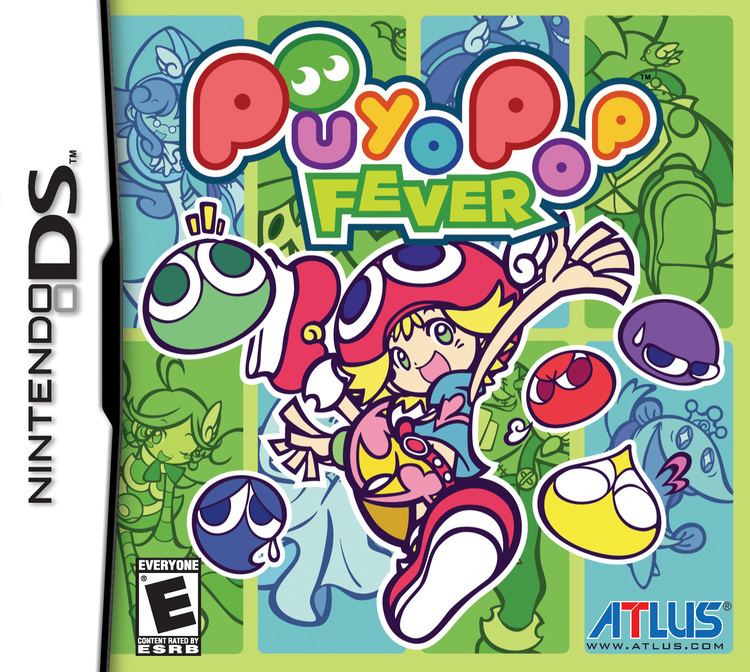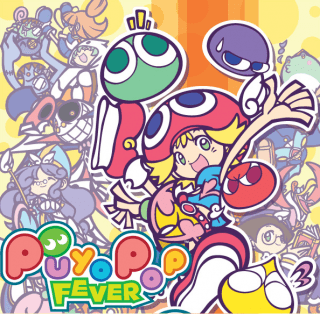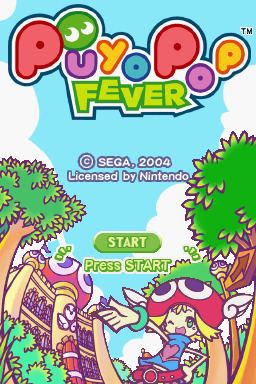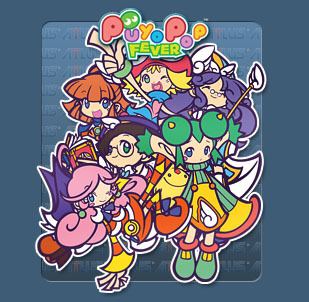8.2 /10 1 Votes8.2
8.5/10 IGN Director(s) Takashi Yuda Artist(s) Yuji Uekawa Initial release date November 2003 | 4.6/5 Emuparadise 72% GameFAQs Composer(s) Hideki Abe | |||||||||||||||||||||||||||||||||
 | ||||||||||||||||||||||||||||||||||
Mode(s) Single-player, Multiplayer Designers Yuji Naka, Takashi Thomas Yuda Similar Puyo Puyo games, Sonic Team games, Puzzle video games | ||||||||||||||||||||||||||||||||||
Puyo pop fever game grumps vs
Puyo Pop Fever (ぷよぷよフィーバー (Puyopuyo Fībā), is a puzzle video game developed by Sonic Team. It is the fifth main installment in the Puyo Puyo puzzle game series and the second Puyo Puyo game to be programmed by Sonic Team after Puyo Pop (which was released just after the series' original developer, Compile, went bankrupt). Sega, which acquired the series' rights from Compile in 1998, published all the Japanese versions of the game; the game was scarcely released internationally, and certain versions were released by other publishers in those areas. Only the Nintendo GameCube and DS versions were released in North America; Europe received both versions plus the Xbox, PlayStation 2, Game Boy Advance, and PlayStation Portable versions. The NAOMI port to Dreamcast, released only in Japan, was the last Dreamcast game developed by Sonic Team.
Contents
- Puyo pop fever game grumps vs
- Nerd fw puyo pop fever
- Gameplay
- Plot
- Characters
- Unlockable characters
- Soundtrack
- Mobile remake
- Reception
- Legacy
- References

Nerd fw puyo pop fever
Gameplay

The basic game mechanics are mainly similar to those of Puyo Puyo: the player has a 6x12 board, and must decide where to place incoming groups of variously-colored blobs, or puyo. After placing each set of puyo, any groups of four or more of the same colored adjacent puyo will pop. Any above will fall down and can form more groups for a chain reaction.

Each time groups of puyo pop, the player will score points and send "trash" (aka "garbage" and "nuisance") to their opponent. Garbage temporarily gets stored in a bar above the playfield, represented by symbols and warning the player of an incoming amount of garbage. These trash puyo are colorless and will only pop when puyo next to them do so, rather than in groups as normal. These will only fall if the player fails to make a chain, and trash falls in groups of 30 (one rock) at a time. When a player's board fills up, either if they cannot make groups or if they are sent a large amount of trash (usually the latter), they lose and the other player will win.

A new addition to the game mechanics is Fever mode. Fever mode occurs when a bar in the middle of the screen is filled up. To fill the bar, one must offset (or counterattack) the trash being sent to the field by the opponent. Every chain, which is a single popping of puyo, will fill one space in the fever meter until it is full, which is when fever activates. In fever mode, a pre-designed chain will fall onto an empty field. In a limited amount of time, one must find a trigger point in the puzzle, which will cause a large chain to go off and attack the opponent. Once a chain is made, another puzzle falls, bigger and more complicated than the previous one. This keeps occurring until time runs out, then it returns the player to his or her original field.

The Nintendo DS version supports 2 to 8 players, as opposed to the others which only support 2 or 4. In this mode, one can play as any available character.

There is also an endless mode, where one can practice fever mode, complete small tasks as they are given, or play the original game. However, the grid and all clear rules remain the same as they do in fever, so it's not exactly classic.
Plot
Ms. Accord, a teacher at the Primp Magic School, has lost her Flying Cane, the equivalent of a magic wand, and claims to have a reward for the student who can find it. The player plays the role of either Amitie or Raffine, students at the school, as they venture across the Puyo Pop Fever world to find the cane, while meeting many wacky characters along the way and battling them. Raffine's course contains more difficult gameplay and alters the characters the player meets, as well as which character actually finds the wand. When playing as Raffine near to the end of the game, it is revealed that Accord never actually lost her flying cane. Raffine then plans on revealing her and Popoi's secret, but fails in her ending, as she is knocked unconscious by Ms. Accord, losing all memories of the flying cane incident. She regains consciousness near her school where Amitie and her friends congratulate her.
Characters
The different characters of Puyo Pop Fever offer different gameplay. With the addition of groups of three and four Puyos, unlike previous Puyo Puyo games, each character has his or her own pattern of which different types of Puyo groups fall onto the field. All the characters are playable in most of the game modes, the only exception being Story Mode, where one must be Amitie or Raffine, respectively. There are also two hidden characters, one possessing a powerful pattern of Puyo groups.
Voiced by: Shiho Kikuchi (Japanese); Evelyn Huynh (English)
Amitie is the protagonist of the game. She wears a large hat called the Red Puyo Cap (あかぷよぼう, Akapuyobō), and is never seen without it. Amitie wishes to be a skilled user at magic, although she does not take a full understanding of most situations. She does not take insults personally, and acts ignorant when Raffine insults her. Amitie is the player character in the RunRun and WakuWaku courses. Her name is French for friendship.Voiced by: Makoto Yasumura (Japanese); Mark Atherlay (English)
Oshare Bones is a skeleton who is often confident in himself. He has a distinct and sophisticated sense of fashion, and tends to criticize those who are not as fashionable as he in his opinion.Voiced by: Mie Sonozaki (Japanese); Thessaly Lerner (English)
One of Amitie's classmates, who works hard in his studies and takes pride in his intelligence. During the game's different stories, he claims to know the whereabouts of Ms. Accord's flying cane. Klug is rumored to have a demon possessing him; in actuality, the demon is possessing his book. During battles, Klug uses astrological spells named in Latin. Klug is the German word for 'clever'.Voiced by: Naomi Wakabayashi (Japanese); Ali Johnston (English)
Dongurigaeru is an aptly-named creature who resides in an acorn and moves about by rolling. His name is also a pun on the word dengurigaeri (でんぐり返り, "forward roll").Voiced by: Noriko Namiki (Japanese); Giovani Pico (English)
Rider is a generally shy girl that tends to stutter often. Her hair is kept in buns to hide her horns, and her outfit has elongated sleeves, which are used to hide her arms. Rider has the ability to control the weather, using lightning] and wind-based spells named in Italian.Voiced by: Noriko Namiki (Japanese); Evelyn Huynh (English)
Onion Pixy is an oni with an onion-shaped head. As his dialogue is limited to words relating to the words 'onion' and 'oing', he cannot be understood. He attacks using his spiked club.Voiced by: Naomi Wakabayashi (Japanese); Ali Johnston (English)
An aptly-named fish prince who resides in the sea. He speaks in an archaic dialect, and in Japanese, all of his dialogue is written in katakana. In English, some of his voice clips quote the Bible.Voiced by: Noriko Namiki (Japanese); Brett Walter (English)
Raffine is another of Amitie's classmates. She thinks highly of herself, and often calls out on everyone she encounters. She is the player character in the HaraHara Course. She does not have high magic skills, so she uses her yellow pouch to use physical attacks as magic; these attacks are of varying elements, and are named in French. Raffine's name is French for 'refined'.Voiced by: Tamaki Nakanishi (Japanese); Giovani Pico (English)
A friendly ghost who enjoys making puns. As such, she uses attacks relating to cultural depictions of ghosts and the afterlife. Yu's name derives from the former part of yūrei (幽霊, "ghost"). Official information states that Yu is searching for her brother, though this is not mentioned in-game. In the English dub, the name's of Yu's attacks are popular culture references, including one to Ghostbusters.Voiced by: Takuo Kawamura (Japanese); Mark Atherlay (English)
Tarutaru is a large classmate of Amitie and Raffine; his name roughly translates to ordinary. He does not possess any magical abilities; instead, he uses physical attacks such as stamping and tackling.Voiced by: Takuo Kawamura (Japanese); Mark Atherlay (English)
A large bespectacled bird, whose attacks all have the word hohou in their names. In the English version, this is instead changed to 'mm-hmm' and his dialogue involves similar words.Voiced by: Miwa Kouzuki (Japanese); Irene Trapp (English)
Accord is the teacher of Amitie's magic class. She is an enigmatic character, as well the character behind the events occurring during the game involving the flying cane and Popoi. Most of her attacks are Italian words dealing with music, such as allegro while her name comes from the French for chord. Whether she is supposedly evil or not, is unknown.Voiced by: Takuo Kawamura (Japanese); Mark Atherlay (English) (Frankendad)
Voiced by: Mie Sonozaki (Japanese); Brett Walker (English) (Frankenson)
Voiced by: Mie Sonozaki (Japanese); Ali Johnston (English)
The original protagonist of the Puyo Puyo series. During a Puyo Puyo match, she is somehow teleported to Primp Town, and seeks Amitie's help in being able to return to her own world. Unlike in previous games, where her personality is based on her disdain for characters around her, this trait is ignored. As a reference to previous games in the series, Arle's dropset consists entirely of pairs.Unlockable characters
Voiced by: Miwa Kouzuki (Japanese); Erin M. Cahill (English)
Popoi is a catlike creature that accompanies Ms. Accord during class. He is the main antagonist of the game, being used by Ms. Accord as a minion to fight Amtie and Raffine, the latter of who discovers their secret. The relationship between the Ms. Accord and Popoi is largely unknown, and it is hinted that one is controlling the other.Voiced by: Tamaki Nakanishi (Japanese); Tamaki Nakanishi (English)
Carbuncle is a companion to Arle, although Puyo Pop Fever makes no references to their relationship. He appears in the game as a hidden boss character. Carbuncle is used by Ms. Accord as a distraction to Raffine in the HaraHara Course. He is the most powerful character in the game, with an AI among the highest and a dropset of 48 Puyo, the largest in the game. Carbuncle's speech is limited to "ta-da"; or "guu" in the Japanese version.Soundtrack
PuyoPuyo Fever 1&2 Sound Track ぷよぷよフィーバー1&2サウンドトラック (Puyo Puyo Fībā Saundotorakku) for both games Puyo Pop Fever and Puyo Puyo Fever 2 was released on July 26, 2007. The track has a total of 45 tracks.
Mobile remake
On February 1, 2009, Sega released a remake of Puyo Puyo Fever in Japan for iOS and Android, titled Puyo Puyo Fever Touch (ぷよぷよフィーバー Touch, Puyo Puyo Fībā Touch).
Reception
Edge ranked the game #64 on its list of "The 100 Best Games To Play Today", stating that "Behind sugary visuals lies a game that revels in bringing about the ultimate chain reaction, the play area riddled with hidden score opportunities until the entire screen collapses into implosions of multipliers."
Legacy
In Sega Superstars, there is a game based on Puyo Pop Fever, though the gameplay differs from the original game. The player must position his/her body in a certain position to get the Puyos into a pot of the same color. Bombs will also fall, and if they get into a pot, points are lost.
In Sega Superstars Tennis, a minigame based on Puyo Pop Fever is featured. Players have to clear Puyos by hitting the ball at them. If the ball hits a Puyo touching another Puyo of the same color, all of them disappear and extra points are awarded. Occasionally, some Puyos become garbage Puyos that do not disappear when the ball hits them, but they can be cleared if one of the colored Puyos attached to them are hit. This minigame is played on the stage based on Nights.
